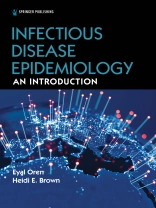Infectious Disease Epidemiology: An Introduction is a foundational textbook for public health and related health science degrees. It provides a comprehensive public health strategy for understanding and managing the spread of infectious diseases. This unique book offers an integrated approach that covers the important methods underlying the discipline of infectious disease epidemiology, while also illustrating key social and environmental factors critical for understanding disease spread and its effect on population health.
The book is divided into four parts that cover the entire scope of infectious disease origin, spread, and management. It breaks down factors leading to disease emergence and modes of transmission, the social, behavioral, cultural, and environmental dimensions that contribute to communicable spread and severity, as well as the tools used for disease detection, surveillance, control, and eradication. It discusses the latest knowledge and technologies in the field—including specific coverage on the role of big data and digital disease detection, the impact and challenges of vaccines, and much more. Core epidemiologic principles are explored through rich real-world examples, utilizing a combination of case studies, popular media examples, and didactic exercises. Each chapter has an engaging narrative and includes key terms and definitions, insightful vignettes, visually compelling illustrations, thought questions, and discussion questions to foster critical thinking and spark further investigation.
Infectious Disease Epidemiology: An Introduction is an essential resource for students of public health and other health professionals in developing a nuanced and comprehensive understanding of this growing and dynamic field.
Key Features:
- Provides students with an integrated approach illustrating important epidemiologic methods and tools in the context of current and historic real-world examples
- Uses multidisciplinary approaches to contextualize broader socio-behavioral factors and disparities in infectious disease
- Illustrates how novel methodological and technological advances support progress in infectious disease epidemiology
- Poses engaging discussion questions in each chapter that help guide in-class discussions and group work
قائمة المحتويات
PART I: DISEASE EMERGENCE AND BASICS
Ch 1: Disease Emergence and Re-emergence
Ch 2: Concepts of Disease TransmissionCh 3: Disease Transmission Dynamics
PART II: MODES OF TRANSMISSION AND TYPES OF DISEASES
Ch 4: Respiratory Diseases
Ch 5: Zoonotic and Vector-borne Diseases
Ch 6: Sexually Transmitted Diseases
Ch 7: Gastrointestinal or Food-borne Disease
PART III: INFECTIOUS DISEASES IN CONTEXT
Ch 8: Behavioral and Cultural Aspects of Infectious Disease
Ch 9: Social Dimensions and Health Equity
Ch 10: Infectious Diseases and the Environment
PART IV: DISEASE CONTROL, ERADICATION, AND EMERGENCE
Ch 11: Infectious Disease Outbreak Detection, Investigation and Surveillance
Ch 12: Vaccines: Impact, Questions, and Challenges
Ch 13: Advances in Disease Control
Glossaryعن المؤلف
Heidi E. Brown, Ph D, MPH is a tenured associate professor of public health in the Mel and Enid Zuckerman College of Public Health at the University of Arizona. Her research focuses on environmental influences on vector-borne diseases and on infectious causes of cancer. In addition to a graduate level spatial epidemiology course and a data analysis and communication course, she has been teaching undergraduate epidemiology since 2013.












